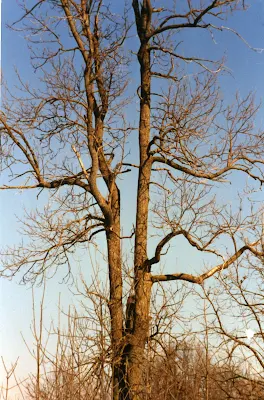
The old Morrison property located on the Morrison sideroad -- the house burned down years ago -- and only this shed remains. There are a few places I would say are "sacred sites" and this is one of them, another is St. Patrick's Church in Montreal. A sacred site doesn't have to be associated with any organized religion (sometimes the opposite prevails), there is a quality of quiet, depth of thought, and spirituality that can be felt at these places. Dowsers can locate them, they exist on ley lines, so you can hold out your hands, palm down, and walk along a country road, and feel the living presence of the earth pulsating in your hands. The Morrison property is located at the junction of the Fourth Concession and the Morrison Sideroad, in Godmanchester, Quebec. I remember in the mid-1990s, often visiting the Morrison property, just to sit and think or be quiet for a few minutes. It was one day, perhaps in 1996, that I decided to sell The Cedars and relocate back to Montreal. I was walking past the Morrison property when I realized that where ever I am living, whatever I have done, that who I am as a human being is a part of my essence. I don't have to live in any particular place, where ever I am I carry with me where I have been and who I am. I am on a journey in life and this is it.
An old oak--important for us Celts--in the middle of a field, on the left side of the Morrison Sideroad as you approach the Morrison Bridge that crosses Trout River from Route 138. I can see Route 138 in the distance...


I made this path just by walking on it from our house to the river. Whenever I think of The Cedars, our old home, I think of Trout River. It was a long commute from the city, about an hour and twenty minutes each way for work, but you certainly felt a lot more in touch with nature when you were out there. And the scenery was beautiful; it wasn't stunning or magnificent, but it was beautiful. The Trout River runs across the U.S. border from the Adirondacks, oddly enough an unpolluted river entering Canada from the States, and then in the perhaps ten miles it's in Canada it becomes polluted. Then, just before you reach Huntingdon, the Trout River merges with the Chateauguay River.
You wouldn't want to drink the water from the Trout River, but you could swim in it, and it wasn't polluted where we lived except with some run-off from farmers' fields. The only "problem" with the river was that it was very shallow, but this was also a good thing, you could swim in places and enjoy the river, but you could also wade the river. If there was one thing I really loved about this area, where I lived for almost twenty years, it was the river. You couldn't really cross country ski there, the snow blew across farmers' fields and became impacted and icy. I skated a few times on the river, and that was fun. Mostly I'd sit in the summer on a rock in the middle of the river, it was quite narrow (maybe twenty or thirty feet wide where we lived) and read and write poems. Or walk down to the river, it was maybe a hundred feet behind the house, and stand by the river and enjoy being there.
Above: Trout River in early spring.
Below: some trees by the river:
















































